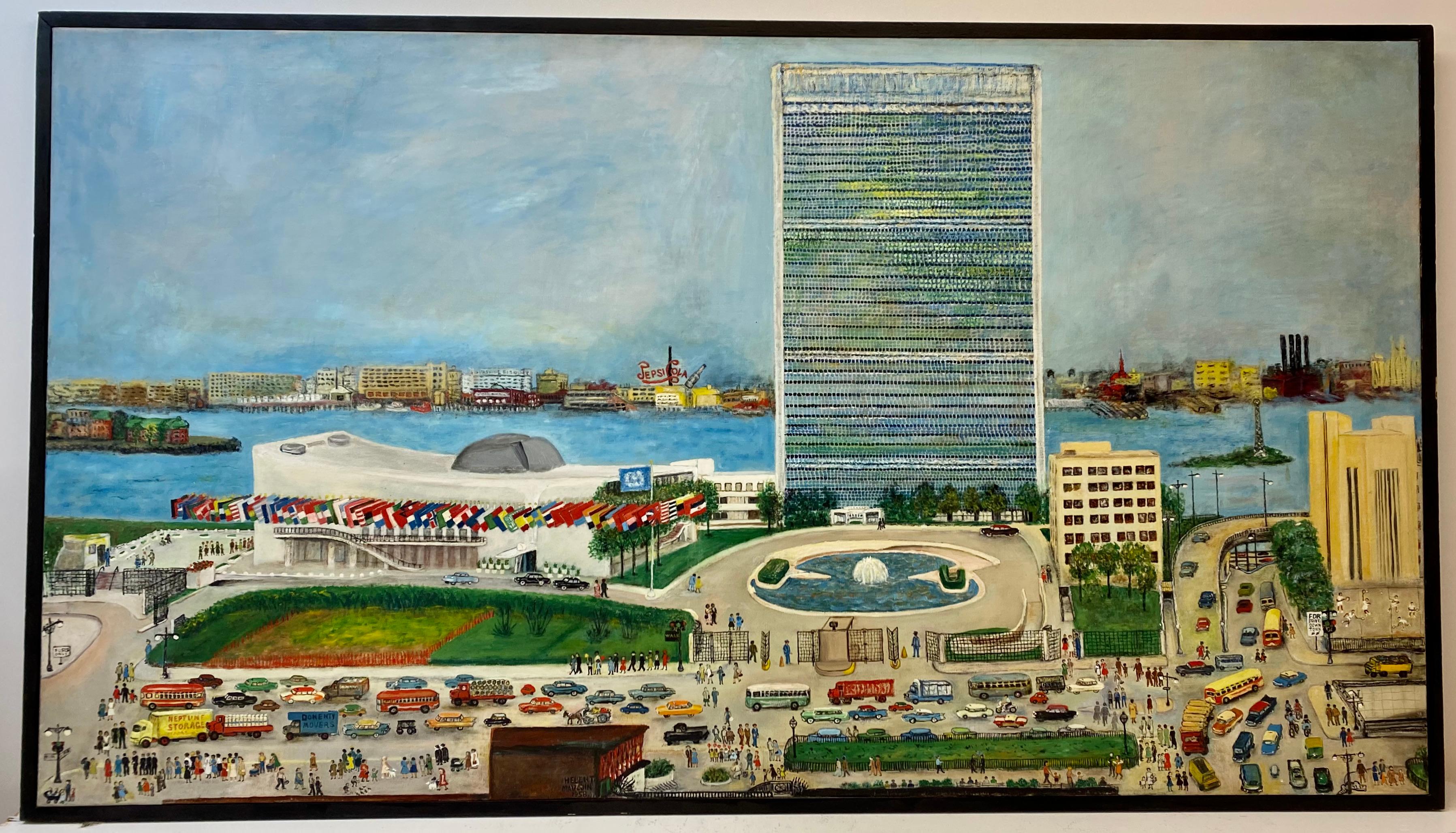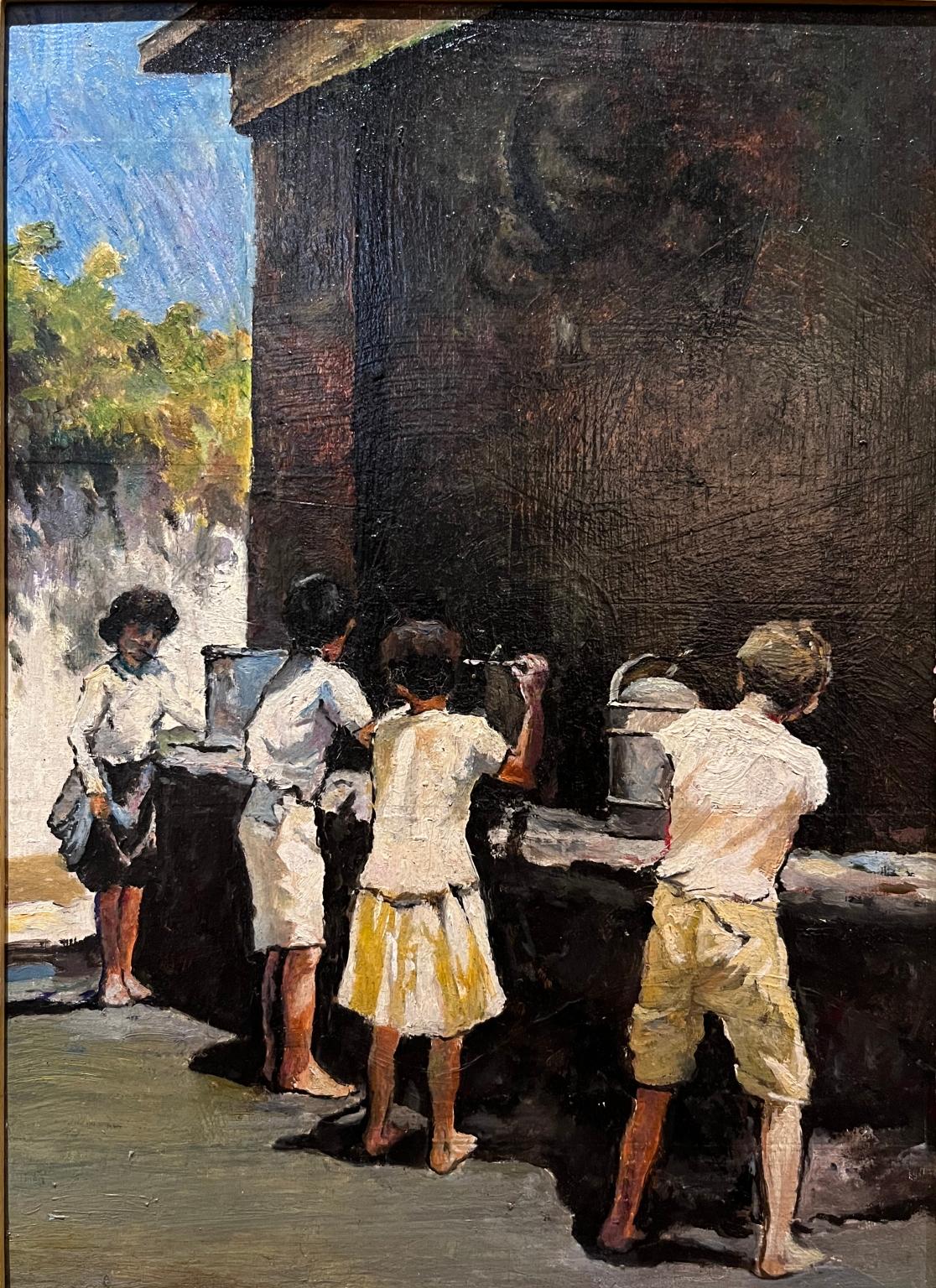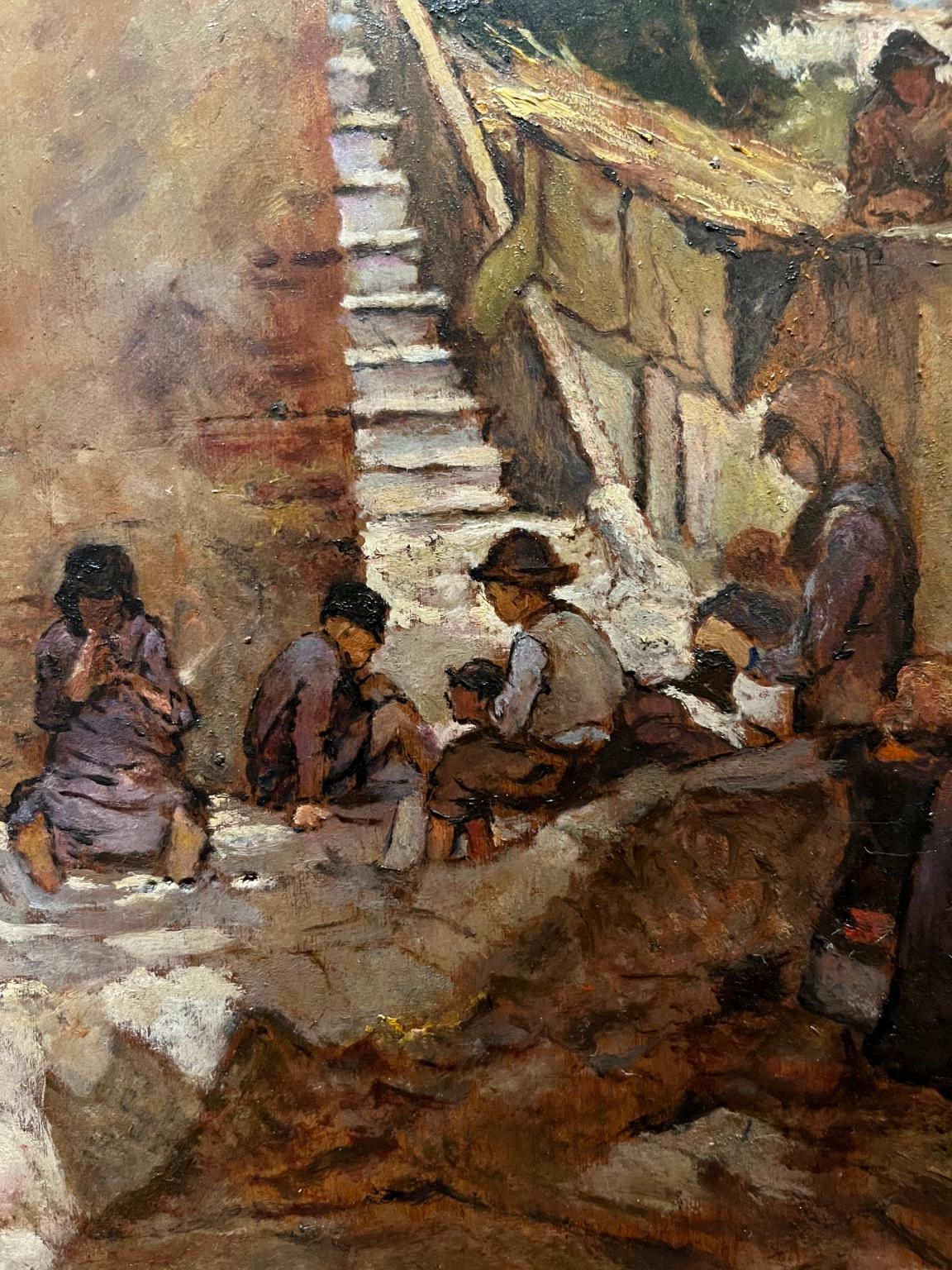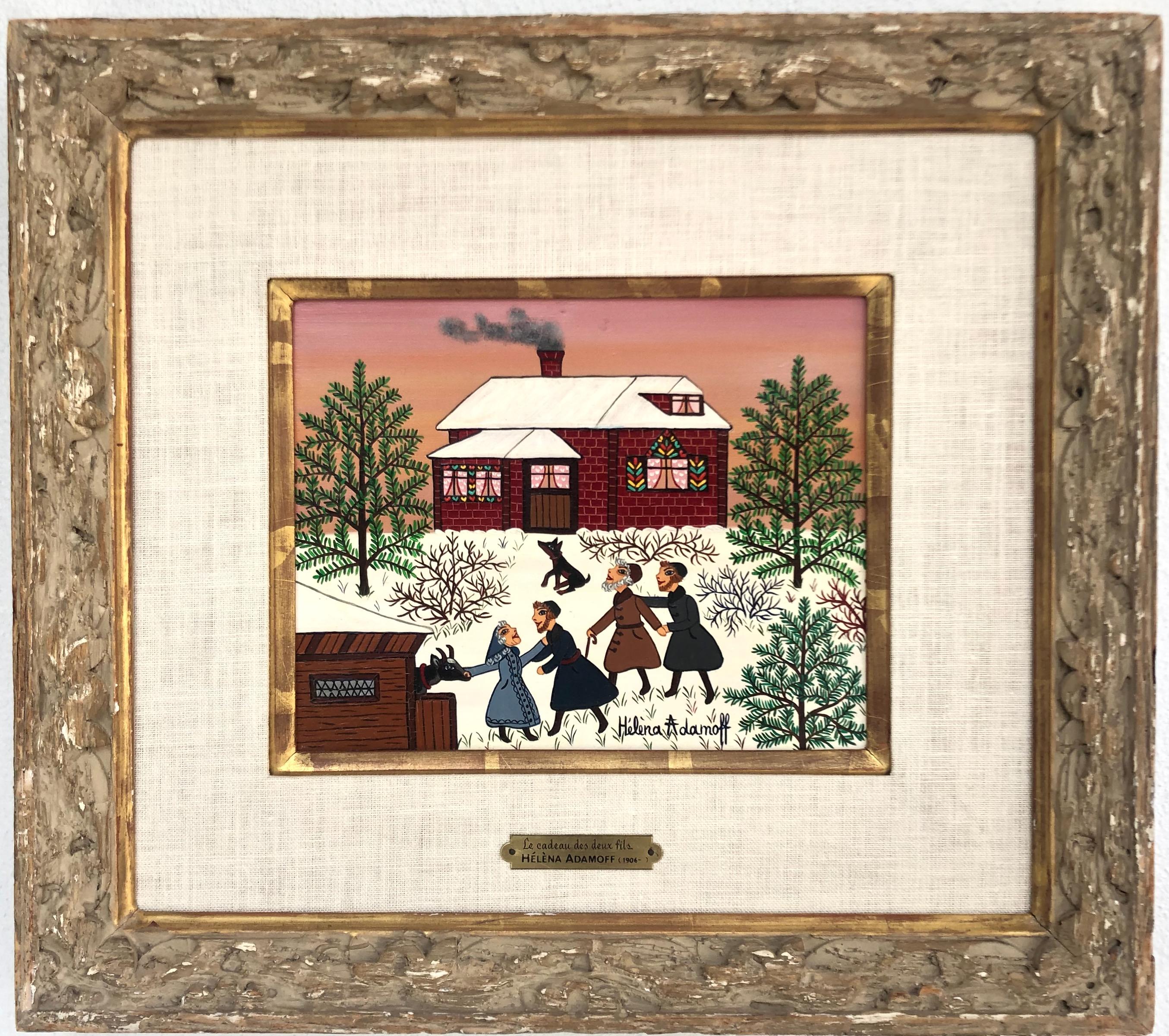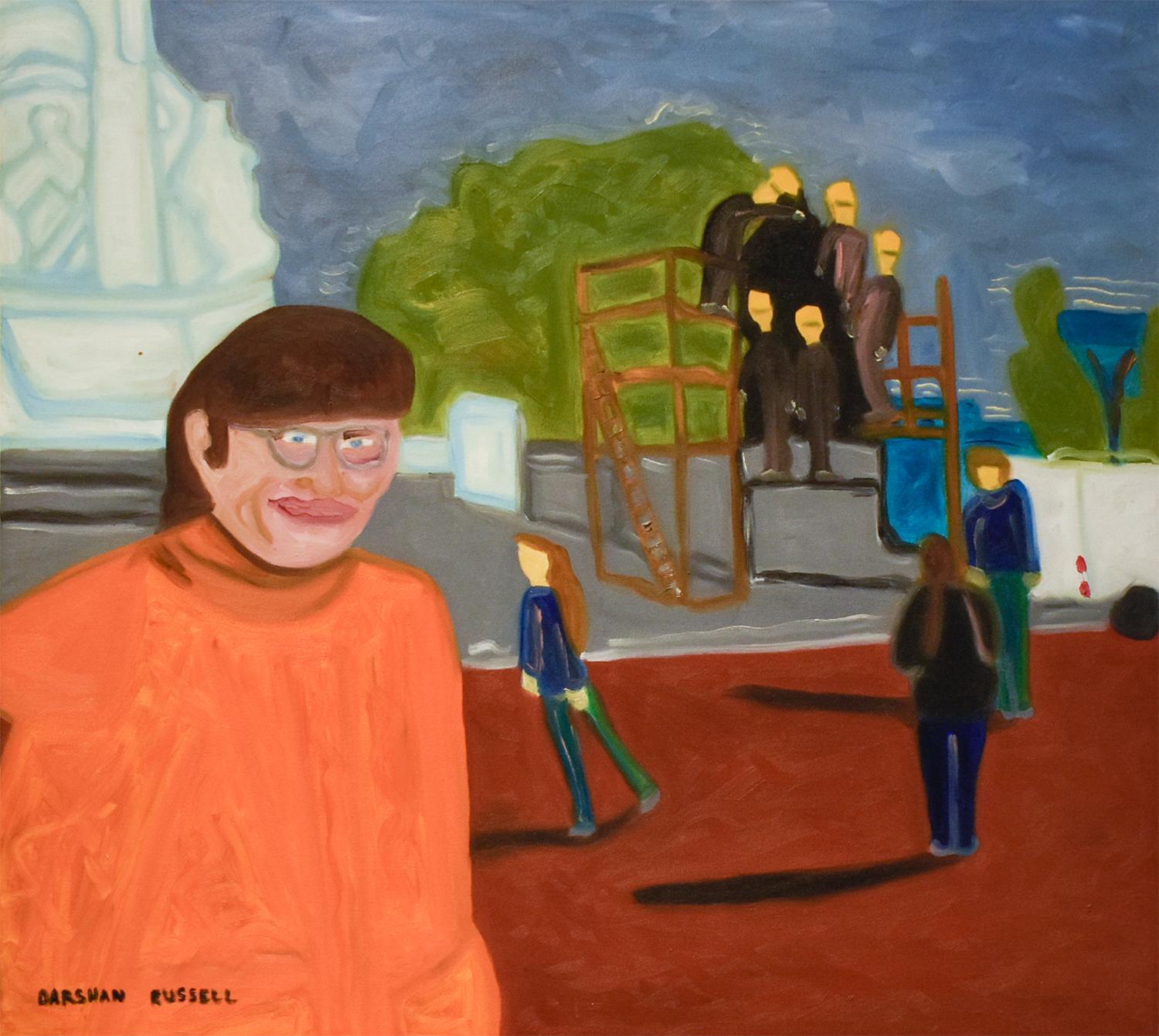Items Similar to Naive London Street Scene Folk Art Oil Painting Big Ben, Parliament, Union Jack
Want more images or videos?
Request additional images or videos from the seller
1 of 11
Andrew MurrayNaive London Street Scene Folk Art Oil Painting Big Ben, Parliament, Union Jack
About the Item
Big Ben, House of Parliament with Union Jack flag, Thames River, boats, barges, airplane and double decker red bus. Classic London street scene.
24 inches by 11 inches in a frame 24.5 inches by 11.5 inches.
ANDREW MURRAY became known and loved as an imaginative Naive painter who captured the character of cities (especially Cape Town and London) with humorous and affectionate insight. An English counterpart to Michel Delacroix of Paris and Charles Fazzino of New York
He was born in north China, the son of a missionary. As a child of five he had his first lesson in painting from the son of another, the 10-year- old Mervyn Peake. Andrew's father, A.H. Jowett Murray, was the youngest son of Sir James Murray, the founding editor of the Oxford English Dictionary.
In 1956, in his 40th year, a chance present led to his breakthrough as an artist. An elderly English artist friend (perhaps by intuition?) gave Murray his own brushes and paints, and he bought himself Norman Colquhoun's Penguin Paint Your Own Pictures. So began the second and increasingly fruitful half of his life.
From the first, Murray's painting meant the release of the interior child which had been waiting for expression. A brief early dalliance with abstract painting taught him to think about structure in a way which became almost instinctive, but abstract forms could not satisfy the child's vision and sense of fun. Inevitably Murray is classified as a "naive" artist, but of a special kind: meditative, seeking the "inscape" of a scene; gently teasing in face of anything grand or pompous, yet without malice.
His subjects can be divided roughly into works of free imagination and evocation of city scenes. The former include biblical and religious subjects (but never too serious), animal and jungle groups, and playful variations on Jungian themes.
It was his Folksy city scenes, however, that gave Murray the success, first in Cape Town (1956-69) and thereafter in London and Paris, which enabled him and his wife to live by his painting. To their sorrow, they had no children of their own, but sales and commissions constantly led to lasting friendships which filled their successive homes with good conversation and laughter. Almost all Murray's pictures set in South Africa have remained there, some now in the National Gallery in Cape Town. In many, Table Mountain rises above the scene, an icon as dominant as Mount Fuji in Japanese painting. The images of street life have a vividness and humour which is rarely if ever surpassed in Murray's later pictures set in London or other European cities.
Murray was taken on by the Portal Gallery (then in Grafton Street) and began a series of successful exhibitions, especially "Poetry into Paintings" and the two series of "Images of Reconciliation"; one of these "images", the lion cradling a lamb, was adopted as a Unicef Christmas card.
Perhaps it was partly the success of this card which suggested a series of gift cards reproducing paintings in colour; once the Murrays had settled (in Chelsea), the cards could give their address, and sales and commissions could be arranged without depending on a gallery. Murray also learned colour etching and for a few years produced a number of successful works, but always concentrated on painting and producing the "Andrew Murray Cards". In the next 20 years the series of these grew to well over a hundred, and in 1980 a selection was reproduced as a book, Andrew Murray's London.
At first the cards (and etchings) included some works of free imagination, but it was the London scenes - both major public monuments and attractive corners, especially of Chelsea - which sold best. Andrew did the paintings and oversaw the colour printing; then Beryl found sales outlets and kept them supplied. People recognised and enjoyed the characteristic clouds like piled puffballs, the ridiculously huge flags and the horses with bulgy Chippendale table legs, pulling drays or carrying policemen, but also, deeper than the fun, the intimate feel for London's moods and a sure sense of structure and colour harmony.
Commissions came from many sides; a set of four Christmas cards, very popular for several years, led to Sheikh Yamani's commissioning a Koranic Nativity to send to his Christian friends. Eventually the most fruitful outlet came to be London Mitsukoshi; they both bought and sold many of Murray's paintings and agreed to his producing cards from the same, while in Tokyo small reproductions on phone cards became fashionable.
In later years the task of distribution became too heavy and the Murrays sold Andrew Murray Cards to Simon Tan, a Singapore Chinese resident in London, who (with his own family) became a close friend and support. One of his developments which has continued is Harrod's annual calendar of Murray's London scenes.
- Creator:Andrew Murray (1917 - 1998)
- Dimensions:Height: 24.5 in (62.23 cm)Width: 11.5 in (29.21 cm)
- Medium:
- Movement & Style:
- Period:
- Condition:frame has wear. minor waviness to canvass. light wear. please see photos.
- Gallery Location:Surfside, FL
- Reference Number:1stDibs: LU3827330992
About the Seller
4.9
Platinum Seller
These expertly vetted sellers are 1stDibs' most experienced sellers and are rated highest by our customers.
Established in 1995
1stDibs seller since 2014
1,541 sales on 1stDibs
Typical response time: 1 hour
- ShippingRetrieving quote...Ships From: Surfside, FL
- Return PolicyA return for this item may be initiated within 3 days of delivery.
More From This SellerView All
- French Folk Art Naive Oil Painting Workers in Vineyard, Les Vignes aux GitansLocated in Surfside, FLMax Savy Oil on canvas painting depicting a village scene with winemakers in a vineyard by artist Max Savy (French, b. 1918). Signed in the lower right. Frame measures 24.5 inches x 28 inches. canvas is 18 X 22 inches., Perfect for a wine cellar or cave. Max Savy (French, 1918-2010) painted scenes of everyday life in the French Corbieres region, which garnered much success during his life. Though the artist remained silent about his early life, it's known his father instilled in him a belief in the humanist socialism philosophy of French Socialist Party leader, Jean Jaures. In 1938, at age 20, he moved to Carcassonne to attend school. There, he married and settled into a teaching position, joining the French Resistance during World War II and earning the Cross of the Combatant. After the war, he created the work for which he is most admired. Max Savy paintings are part of France's heritage collection, and the artist became a knight of the National Order of Merit in 1973. Max Savy's paintings and artworks include scenes of peasants in the fields. Max Savy was active/lived in France. Max Savy is known for folk art style painting of village architecture, vintners, figures in landscape, wine makers, marine scenes. His work is similar in style to the naive, folk art paintings of Michel Delacroix and Fanch Ledan. This is quite similar to a work I had titled "Les Vignes Aux Gitans" (the gypsy grape vines) So i assume this is also a vineyard painting...Category
Mid-20th Century Folk Art Landscape Paintings
MaterialsCanvas, Oil
- Fantastic Village Scene Modern Irish Magic Realism Oil PaintingBy Philip CastleLocated in Surfside, FLPhilip Castle was an Irish Painter and husband to artist Barry Castle He is rarely exhibited. His detailed, meticulous work took a long time to complete...Category
20th Century Folk Art Landscape Paintings
MaterialsCanvas, Oil
- Magic Realist Surrealist Latin American Naive Fantasy PaintingBy German Ramon Duron LanzaLocated in Surfside, FLMagic realist fantasy painting in the manner of Ernst Fuchs and Arik Brauer. Naïve art is any form of visual art that is created by a person who lacks the formal education and training that a professional artist undergoes (in anatomy, art history, technique, perspective, ways of seeing). Unlike folk art, naïve art does not necessarily evince a distinct cultural context or tradition. Naïve art is recognized, and often imitated, for its childlike simplicity and frankness. Paintings of this kind typically have a flat rendering style with a rudimentary expression of perspective. One particularly influential painter of "naïve art" was Henri Rousseau (1844–1910), a French Post-Impressionist who was discovered by Pablo Picasso. Naïve art is often seen as outsider art that is by someone without formal (or little) training or degree. While this was true before the twentieth century, there are now academies for naïve art. Naïve art is now a fully recognized art genre, represented in art galleries worldwide. Museums devoted to naïve art now exist in Kecskemét, Hungary; Riga, Latvia; Jaen, Spain; Rio de Janeiro, Brasil; Vicq France and Paris. "Primitive art" is another term often applied to art by those without formal training, but is historically more often applied to work from certain cultures that have been judged socially or technologically "primitive" by Western academia, such as Native American, sub saharan African or Pacific Island art (see Tribal art). This is distinguished from the self-conscious, "primitive" inspired movement primitivism. Another term related to (but not completely synonymous with) naïve art is folk art. There also exist the terms "naïvism" and "primitivism" which are usually applied to professional painters working in the style of naïve art (like Paul Gauguin, Mikhail Larionov, Paul Klee). At all events, naive art can be regarded as having occupied an "official" position in the annals of twentieth-century art since - at the very latest - the publication of the Der Blaue Reiter, an almanac in 1912. Wassily Kandinsky and Franz Marc, who brought out the almanac, presented 6 reproductions of paintings by le Douanier' Rousseau (Henri Rousseau), comparing them with other pictorial examples. However, most experts agree that the year that naive art was "discovered" was 1885, when the painter Paul Signac became aware of the talents of Henri Rousseau and set about organizing exhibitions of his work in a number of prestigious galleries. The Earth Group (Grupa Zemlja) were Croatian artists, architects and intellectuals active in Zagreb from 1929 to 1935. The group included the painters Krsto Hegedušić, Edo Kovačević, Omer Mujadžić, Kamilo Ružička, Ivan Tabaković, and Oton Postružnik, the sculptors Antun Augustinčić, Frano Kršinić, and the architect Drago Ibler. A term applied to Yugoslav (Croatian) naive painters working in or around the village of Hlebine, near the Hungarian border, from about 1930. Some of the best known naive artists are Dragan Gaži, Ivan Generalić, Josip Generalić, Krsto Hegedušić, Mijo Kovačić, Ivan Lacković-Croata, Franjo Mraz, Ivan Večenaj and Mirko Virius. Camille Bombois (1883–1970) Ferdinand Cheval, known as 'le facteur Cheval' (1836–1924) Henry Darger (1892–1973) L. S. Lowry (1887–1976) Grandma Moses, Anna Mary Robertson (1860–1961) Nikifor (1895–1968) Poland, Horace Pippin (1888–1946) Jon Serl (1894-1993) United States Alfred Wallis (1855–1942) Scottie Wilson (1890–1972) Gesner Abelard (b. 1922) Jan Balet (1913–2009) Michel Delacroix (b. 1933) France Howard Finster (1916–2001) Ivan Rabuzin (1921–2008) Spontaneous Art Museum in Brussels Art en Marge Museum in Brussels MADmusée in Liege International Museum of Naive Art of Brazil in Cosme Velho, Rio de Janeiro Gallery Jacques Ardies in São Paulo Musée international d'art naïf de Magog in Magog Croatian Museum of Naïve Art in Zagreb Gallery of Croatian Naïve Art...Category
20th Century Folk Art Figurative Paintings
MaterialsCanvas, Acrylic
- Large Israeli Naive Art Screen Enamel Oil Painting Jerusalem Old City Folk ArtBy Gabriel CohenLocated in Surfside, FLJERUSALEM, Vielle du David, (City of David) Superlac (enamel) painting on paper, hand signed, titled and dated. Provenance: Michael Hittleman Gallery Los Angeles. Gabriel Cohen, (French-Israeli) Self taught, Naive painter was born in Paris in 1933, to parents from Jerusalem with a father who studied the kabbalah. Throughout World War II, the family hid from the Nazis in Paris. Images of Nazi soldiers appear in several of his paintings. In 1949, when Gabriel was 16, the family returned to Israel. They managed to save enough money to move back to the quarter where both parents were born: Ohel Moshe in Nachlaot. Gabriel served in the artillery corps and after the army, went back to live in his parents' house and earned a living polishing diamonds. The head of the polishing plant, who noticed his employee's artistic skill, allowed him to paint during work hours. He once asked Cohen if he could draw a tiger. Cohen drew him a tiger. And he did a lot of sculpting and painting on glass. He also loved to play the guitar, especially flamenco style. Critics say he is one of Israel's greatest naive-style painters. Along with Shalom of Safed, Kopel Gurwin and Natan Heber, He is renowned as one of Israel's greatest living naive-style folk art painters, recipient of the Jerusalem Prize for Art (1987), a permanent entry in encyclopedias of naive painting, who exhibited his work not only in Israel, but also in Paris, Venezuela, Denmark and Germany; the same Gabriel Cohen whose colorful , bold Naif paintings were exhibited at the Jewish Museum in New York in 1987 alongside works by Marc Chagall; the same Gabriel Cohen about whom curator and art scholar Gideon Ofrat says, "There is no questioning his greatness." He has shown in Paris on the Rue de Rosiers in the Marais. His impressions of his journeys, mostly imaginary, yet some real, are expressed in Cohen's paintings. Huge, colorful canvases rich in precise detail and fantasy, in which he paints the Eiffel Tower and the Russian steppes or the vistas of Paris and the Tower of Babel "In my opinion, it's also because the Tower of Babel has some kind of phallic, erotic meaning, but also because of the internationalism, of the mixture and confusion of nations, which is an essential element in Gabi Cohen's work," says Gideon Ofrat. There is no superlative that has not been lavished on Cohen's work by art critics, since he began showing his paintings at age 40, All the art critics seemed to agree at once that Cohen is one of the greatest naive-style painters in Israel. Their counterparts abroad seconded this view. About a year and a half ago, Zadka organized a show for Cohen at the Jerusalem Artists' House. The Tel Aviv Museum bought a painting of Gabi's and so did the Israel Museum, and several artists bought his drawings. He is a great, great painter. There is no painter who is more of a symbolist and illustrative artist than he is. As a painter myself, I admire him." The Yom Kippur War in 1973 sparked an artistic breakthrough for Cohen; it was at that time that he began to sit on the sidewalk after his work as a diamond polisher and paint. Not long afterward, in early 1974, he did a painting he called "Moses on the Mountain." Ruth Debel, of the Debel Gallery in Ein Kerem, passed by and saw it on the street. She asked how much he wanted for it, and for the first time in his life, he realized that his work had financial value. His first show was at the Debel Gallery in 1974. The response was overwhelming. Cohen was immediately declared a genius. His paintings at the gallery were purchased and he continued to create new paintings. That same year, he was invited to take part in a group exhibition of naive artists at the Kunsthaus in Zurich, and a year later, his work was included in a traveling show of naive-style artists from Israel that was exhibited in Denmark and Germany. Soon after that he was invited to be part of group shows in Venezuela and at the Tel Aviv Museum. Cohen had four solo shows at the Debel Gallery. Awards And Prizes 1987 Jerusalem Prize for Painting and Sculpture 1999 Shoshana Ish-Shalom Prize for special contribution to art, Jerusalem He has exhibited alongside all of the Israeli great artists. included in the Naive Art Group exhibition Gvanim Art Gallery, Jerusalem Rubin, Rachel Roman, Yitzhak Zarembo, Leah Moscovitz, Shalom (of Safed) Steinberg, Michael Denisov, Salva Harbon, Haim Cohen, Gabriel Chanannia, Joseph (Jojo) Local Hero...Category
20th Century Folk Art Landscape Paintings
MaterialsPaper, Oil, Alkyd
- French Mod Surrealist Commedia dell'arte Circus Scene Oil Painting J.P. SerrierBy Jean Pierre SerrierLocated in Surfside, FLJean Pierre Serrier (French, 1934-1989) Oil on canvas painting depicting four figures Hand signed lower right. Measures (frame) 26.5" x 30" wide, and (sight) 18.25." x 22.25" wide. Jean Pierre Serrier (1934 – 1989) was a French painter known for surrealism and absurdist art. Jean-Pierre Serrier was born in Montparnasse, Paris and attended the Académie des Beaux-Arts in Paris. the son of Louis and Solange Serrier. His father fought in World War II and became a prisoner of war. In 1940, as a six-year-old, he and his mother fled Paris for Corrèze in southwest France. Childhood memories of close escapes from German bombardments would later influence his absurdist philosophy of life. Passionate about drawing, in 1951 he applied and was admitted to the École nationale supérieure des arts appliqués et des métiers d'art in Paris. He shared an attic apartment in the 16th arrondissement with fellow student Jean-Baptiste Valadié. For income, he decorated shop windows. A trip to Spain provided motifs for early works. His student work might be characterized as art naïf (Naive art). While still a student, he sold a ceramic artwork to the poet and publisher Pierre Seghers, who would later commission drawings from him. He frequented jazz clubs in Saint-Germain des Près, and while listening to Sidney Bechet at the Vieux Colombier, he met his wife, Yvette.One of the last French Surrealist and follower of Nietzsche. His art conveyed the message to all of mankind that we are only human. The other Surrealist to center his art in philosophy was Rene Magritte whose paintings reflect his understanding of Sigmund Freud. He had his first exhibition in 1955, before being sent to Algeria to complete his military service. After graduating in 1955, he was drafted for military service, spent time in Germany and Morocco, and was sent to the front lines of the Algerian War. In 1959 he exhibited works at two Parisian galleries and at Juan-les-Pins on the Côte d'Azur. From 1961, he exhibited annually at the Salon des Artistes Français. In 1962, the City of Paris purchased his painting Un dimanche In 1961, Serrier made his first visit to the United States to exhibit at a New York gallery. In 1975 and 1979, he had successful exhibitions in New Orleans, and his work was included in art and news magazines, including Time and Newsweek. Beginning in the 1950s, his works included stylized portraits similar in some ways to the "big eyes" art of Margaret Keane, though it is uncertain that either artist influenced the other. Keane painted children, and so did Serrier, sometimes from life, but Serrier’s models are usually somewhat older, though uniformly slender and with androgynous features. A gallery owner introduced Serrier to American collectors Edgar Garbisch and his wife, Bernice Chrysler (daughter of Chrysler founder Walter P. Chrysler), who had a particular interest in naïve art; they commissioned a series of portraits from Serrier. At the same time, he met Reine Ausset in Paris, who in 1961 invited him to New York to take part in an exhibition at Galerie Norval on 57th Street. The show also included work by Moïse Kisling, and the exhibition program explicitly linked the two artists, saying that Serrier, who considered Moise Kisling "the Master," had found his own technique, but "the same vision joins the grand Kisling to the young Serrier: plenitude of shapes, sureness of palette, precision in outlines." In the 1960s he began painting slender, young, androgynous figures in groups, set in sparse landscapes with suggestions of the surreal and sometimes wearing costumes of the Commedia dell'arte. In some of these paintings the eyes of the figures are completely black, a motif that would continue in his later work. In 1965, he exhibited at Forest and Reed Gallery in London. Also in 1965, he discovered the small town of Martel, and with his old roommate Jean-Baptiste Valadié purchased a house that they opened as the gallery La Licorne (The Unicorn) in 1967. Responding to the political upheavals of May 1968 in France, and following the advice of Geneva gallery owner Roger Ferrero, Serrier's work became increasingly complex, idiosyncratic, and surreal. Imagery included the Tower of Babel, bodies suspended in space, and crowds of people all dressed alike, with identical features and entirely black eyes. Mannequins, playing cards, nudes, and levitating orbs also figured in the work. In a nod to Magritte, his men sometimes wear bowler hats. Another influence may have been the works of the Franco-Belgian surrealist Gaston Bogaert (1918-2008). Serrier's first major exhibit of these works, in Geneva in 1971, was titled Le Réalisme Fantastique. (Magic Realism) In 1972, he was made a member of the Société du Salon d'Automne, under whose auspices he was invited by the Polish government to exhibit in Warsaw in 1973, as part of a cultural exchange across the Iron Curtain. In 1976, he served on the jury of the Salon d'Automne. In 1975, New Orleans gallery owner Kurt E. Schon brought his work to several cities in the United States. A copiously illustrated monograph in English, Surrealism and the Absurd: Jean Pierre Serrier, was published in 1977. Author Thomas M. Bayer wrote: Serrier's world is one where—to use Friedrich Nietzche's term—the "human herd animal" is being confronted with the overwhelming task of coping with the world, his solitude, and at times, his resignation in the face of its monstrous size and duration. It is a world where the characterless, "blind" man faces the institutions, rules and symbols that made him into the being he now is…But Serrier does not lose himself in this world he portrays. He never forgets the old French tradition, the "black" humor, à la Molière. This classical humor at times is more felt than seen, in a manner that can be terribly funny, because it is horrifying, laughable, poignant and always true. Serrier told a friend, "In each of my paintings there's a message of hope amid the crowd of stereotypical figures. It could be an escaping dirigible, or a nymphet who flees like a deer under the red and blue trees of paradise...Category
Mid-20th Century Surrealist Figurative Paintings
MaterialsOil, Canvas
- 1927 Oil Painting Eiffel Tower Paris American Modernist Wpa Artist Morris KantorBy Morris KantorLocated in Surfside, FLMorris Kantor New York (1896 - 1974) Paris from the Ile St. Louis, 1927 (view of Eiffel Tower) Oil painting on canvas Hand Signed lower left. Provenance: Hirshhorn Museum and Sculpture Garden, Smithsonian Institution ( bears label verso) Size: 20 3/4"H x 28 1/8"W (sight), 28.75 "H x 36"W (framed) Morris Kantor (Belarusian: Морыс Кантор) (1896-1974) was a Russian Empire-born American painter based in the New York City area. Born in Minsk on April 15, 1896, Kantor was brought to the United States in 1906 at age 10, in order to join his father who had previously relocated to the states. He made his home in West Nyack, New York for much of his life, and died there in 1974. He produced a prolific and diverse body of work, much of it in the form of paintings, which is distinguished by its stylistic variety over his long career. Perhaps his most widely recognized work is the iconic painting "Baseball At Night", which depicts an early night baseball game played under artificial electric light. Although he is best known for his paintings executed in a realistic manner, over the course of his life he also spent time working in styles such as Cubism and Futurism, and produced a number of abstract or non-figural works. A famous cubist, Futurist, painting of his "Orchestra" brought over 500,000$ at Christie's auction house in 2018 Kantor found employment in the Garment District upon his arrival in New York City, and was not able to begin formal art studies until 1916, when he began courses at the now-defunct Independent School of Art. He studied landscape painting with Homer Boss (1882-1956). In 1928, after returning to New York City from a year in Paris, Kantor developed a style in which he combined Realism with Fantasy, often taking the streets of New York as his subject matter. He did some moody Surrealist Nude paintings and fantasy scenes. In the 1940's he turned towards figural studies. Later in his career, Kantor himself was an instructor at the Cooper Union and also at the Art Students League of New York in the 1940s, and taught many pupils who later became famous artists in their own right, such as Knox Martin, Robert Rauschenberg, Sigmund Abeles and Susan Weil...Category
1920s American Modern Landscape Paintings
MaterialsCanvas, Oil
You May Also Like
- Helen Mauldin New York City "United Nations" Large Scale Folk Art Painting 1958Located in San Francisco, CALarge Scale New York City "United Nations" Folk Art Painting by Helen Mauldin c.1958 Fine mid century primitive outsider folk art painting of an aerial view of United Nations Plaza in New York City looking towards Long Island City, in the New York City borough of Queens. There is so much color and detail in this painting. Hundreds of people from school children, groups of people playing tennis, bus drivers, policemen, pedestrians, etc., all out on a beautiful blue sky day. There is a lot happening in this painting; you're sure to see something different every time you look at it. The painting is very large and is painted on canvas. Signed by the outsider artist Helen T...Category
Mid-20th Century Folk Art Landscape Paintings
MaterialsCanvas, Oil
- Tuscan Figurative Genre Scene painting 20th century oil on canvasLocated in Florence, ITThe artist of this painting is unknown but it can be ascribe to a Tuscan movement of the 20th century inspired by 19th century art like Verismo (as we can deduce by the clean and not...Category
20th Century Folk Art Figurative Paintings
MaterialsCanvas, Oil
- Tuscan Figurative Genre Scene painting 20th century oil on canvasLocated in Florence, ITThe artist of this painting is unknown but it can be ascribe to a Tuscan movement of the 20th century inspired by 19th century art like Verismo (as we can deduce by the clean and not...Category
20th Century Folk Art Figurative Paintings
MaterialsCanvas, Oil
- The Gift Of The Two Lines Small Oil PaintingLocated in Delray Beach, FLThe Gift Of The Two Lines Born on March 21, 1906, in Moscow, she arrived as an emigrant to Paris at the age of 15, bearing in her young experience, the weight of the most transformi...Category
1960s Folk Art Landscape Paintings
MaterialsCotton Canvas, Oil
- Self Portrait (Colorful Faux-Naif Figurative Cityscape Oil Painting)By Darshan RussellLocated in Hudson, NYColorful Faux Naive Style Cityscape Painting, Portrait of the Artist 'Self Portrait' painted by Darshan Russell in 1997 Oil on canvas, 21.5 x 24 inches framed with thin wood strippin...Category
1990s Outsider Art Landscape Paintings
MaterialsCanvas, Oil
- Parked Cars: Modern, Naive Style Square Oil Painting of Cars in a Gray LotBy Darshan RussellLocated in Hudson, NYOil on board 19 x 19 inches in dark brown wood frame 18 x 18 inches unframed This modern, abstracted naive style oil painting was made by Poughkeepsie, NY based artist Darshan Russe...Category
2010s Folk Art Landscape Paintings
MaterialsCanvas, Oil
Recently Viewed
View AllMore Ways To Browse
Vintage Leg Art
Japanese Street Art
Old London Vintage
Old Vintage London
Big Faces
Boat Art Set
Chelsea London
London Streets Oil
Union Of London
North African Art Paintings
Oil Paris Street Scene
Paris Street Scene Oil Painting
Street Scenes Of Paris Oil Paintings
Airplane In Art
Big Five
Vintage Childrens Book Art
The Big Five
Union Flag
